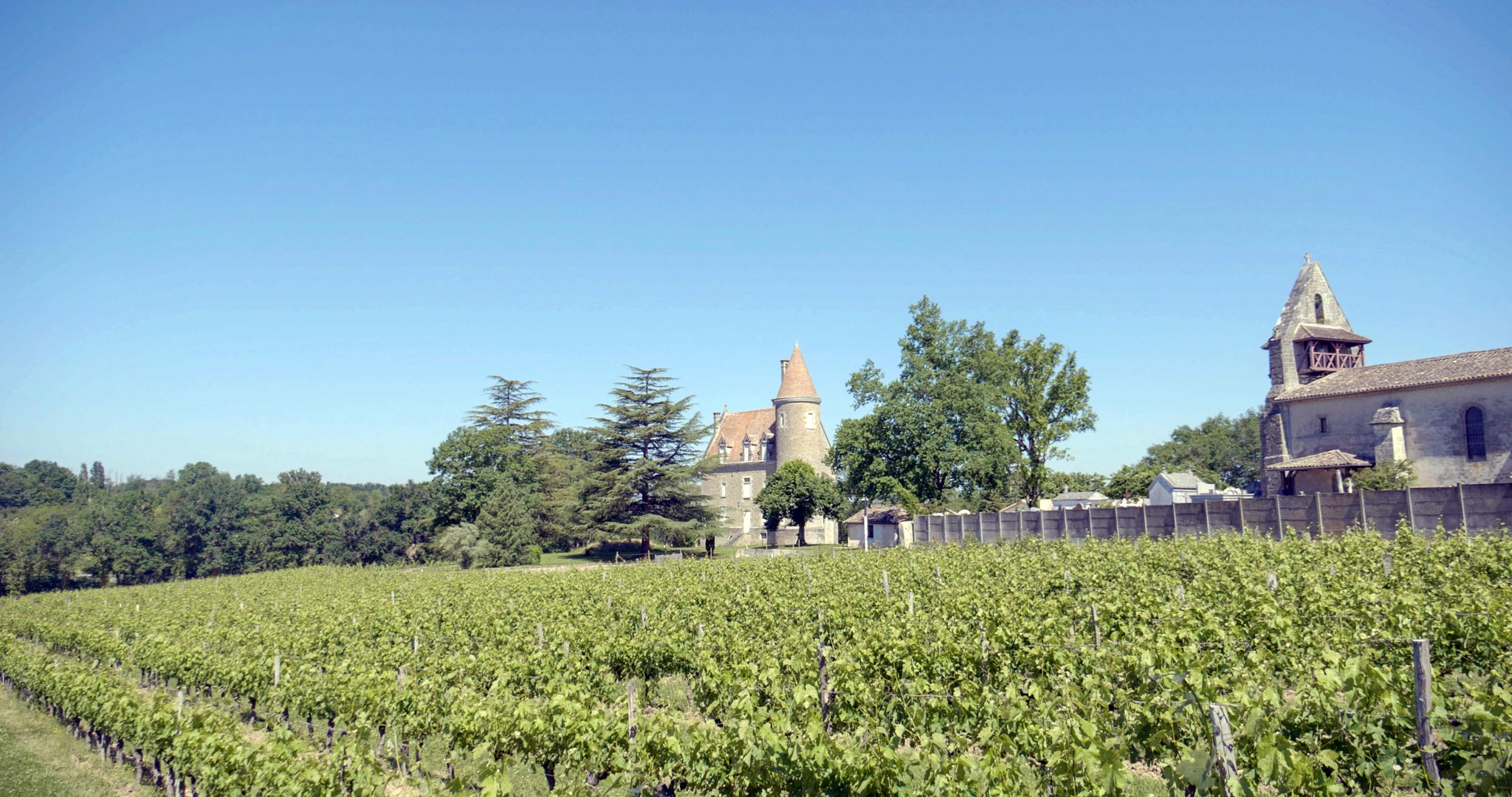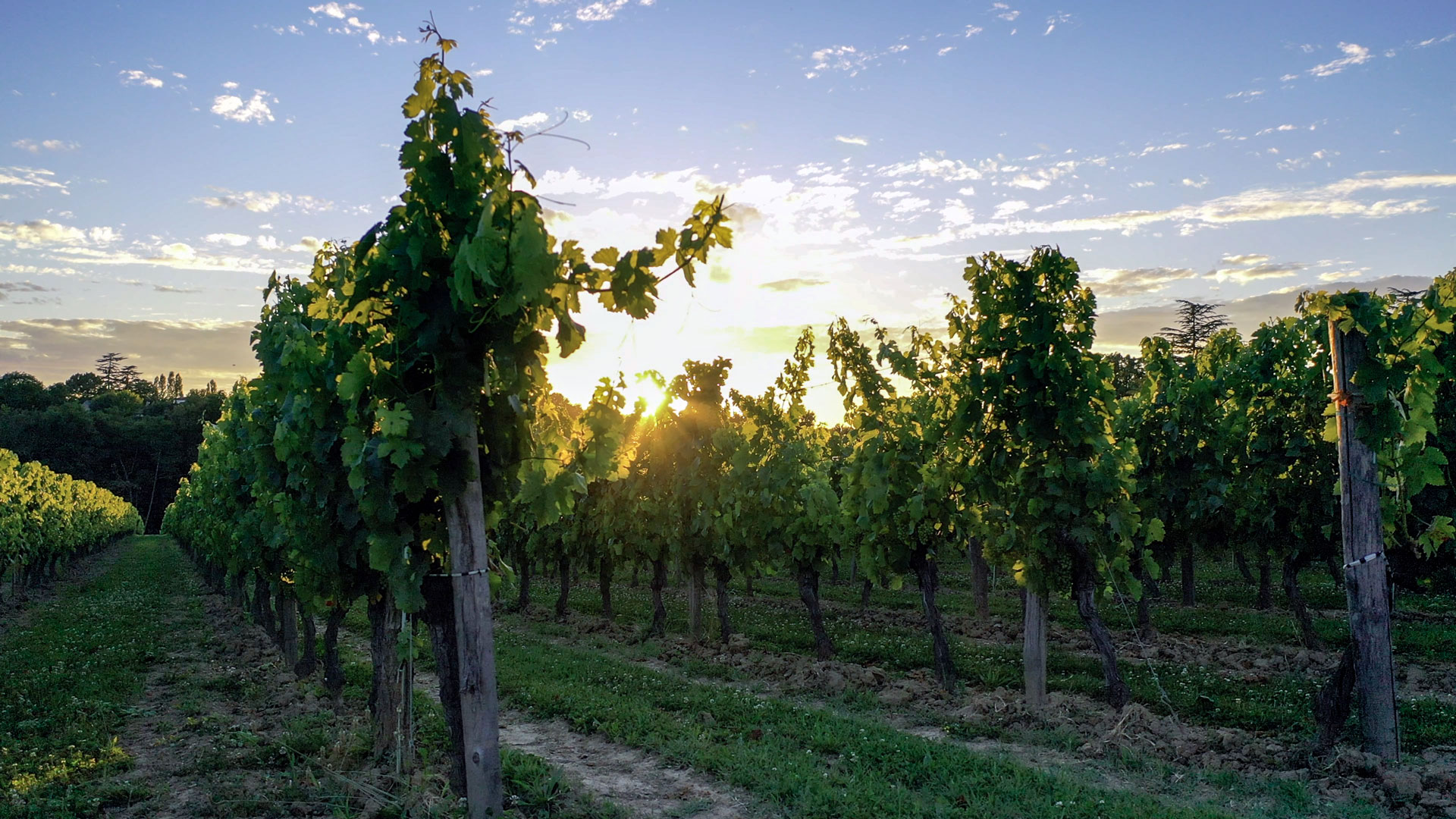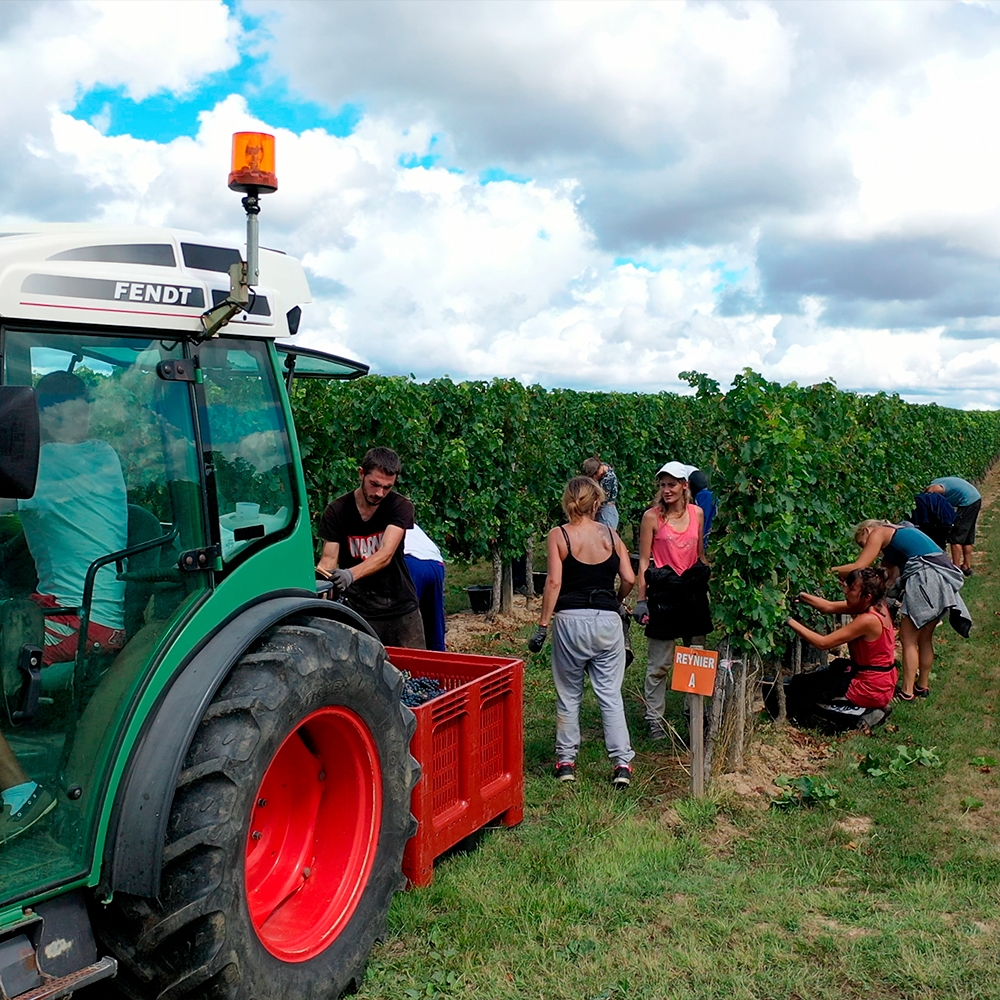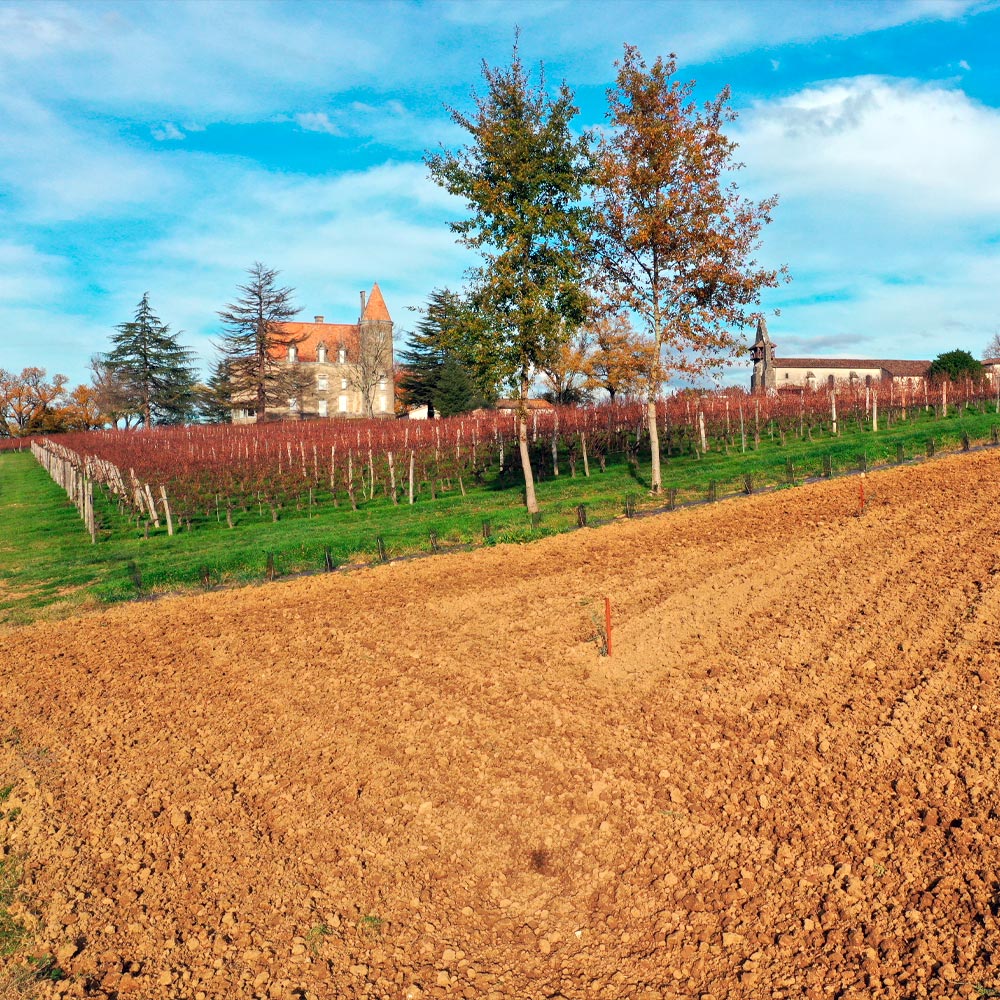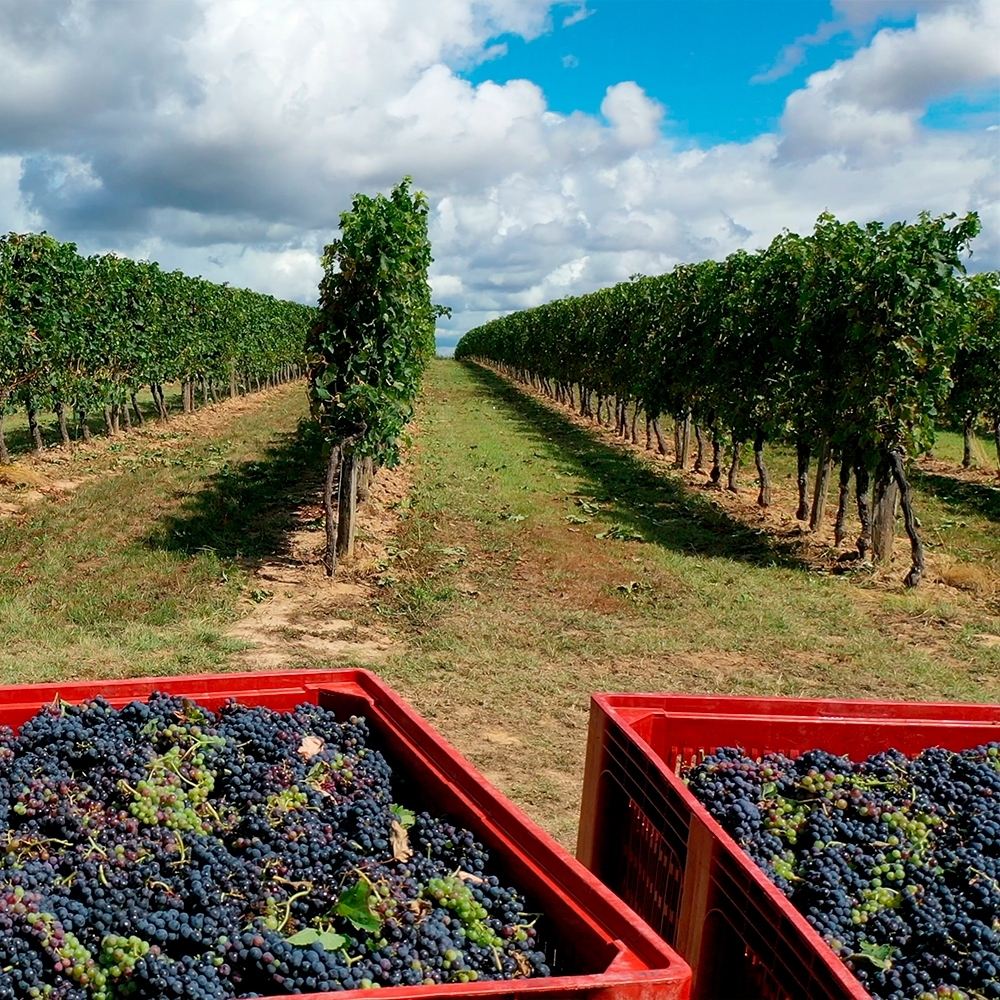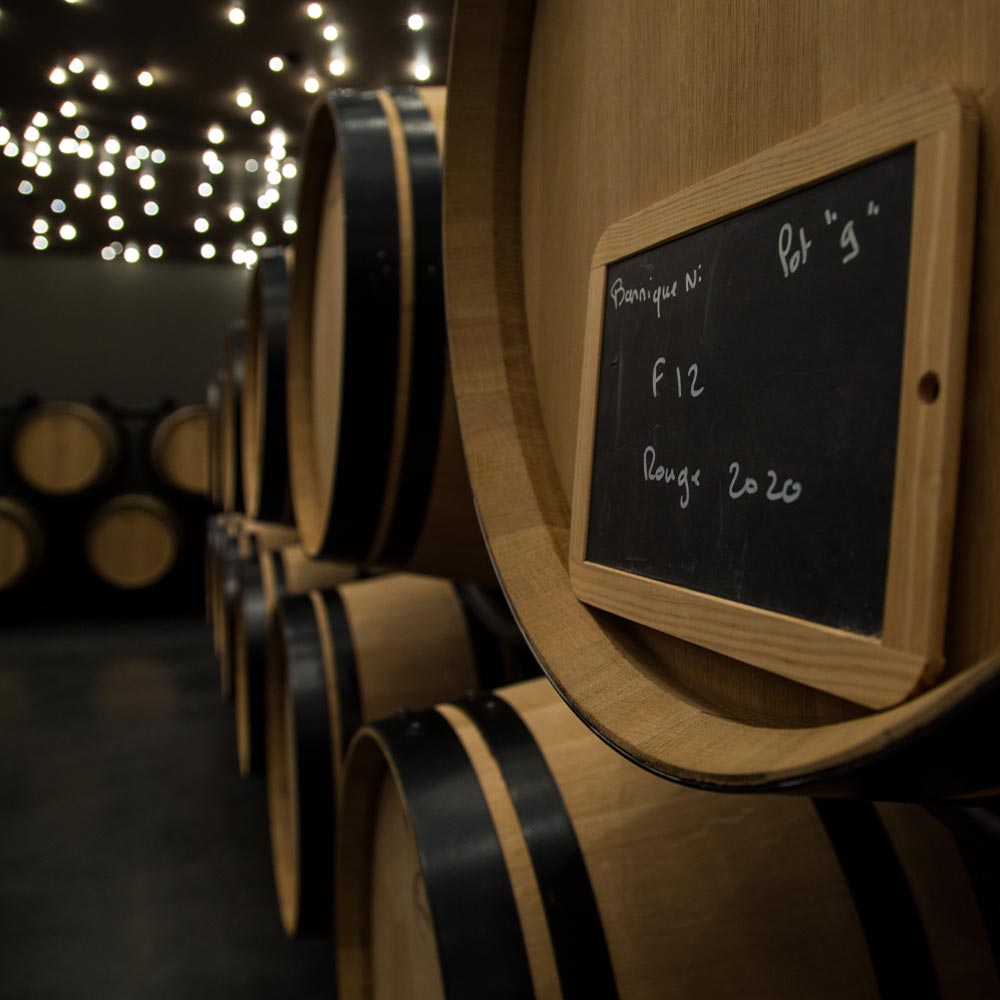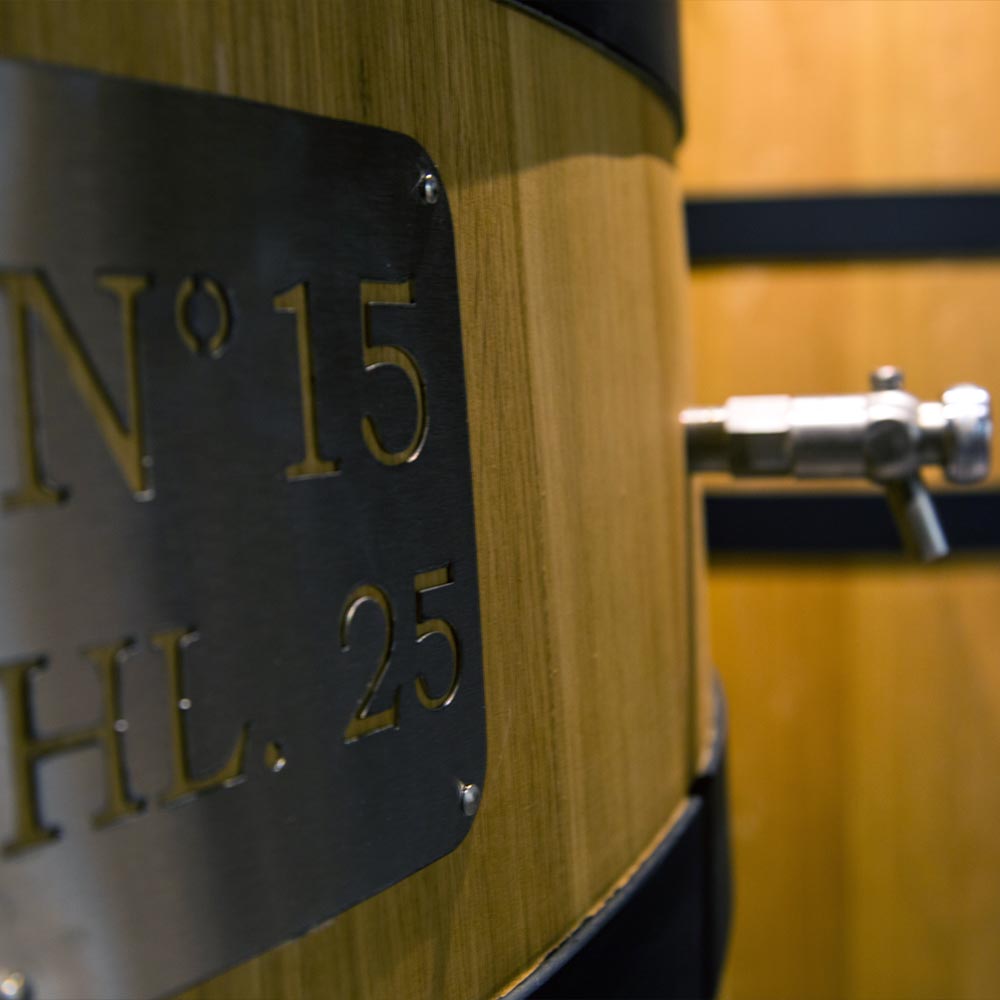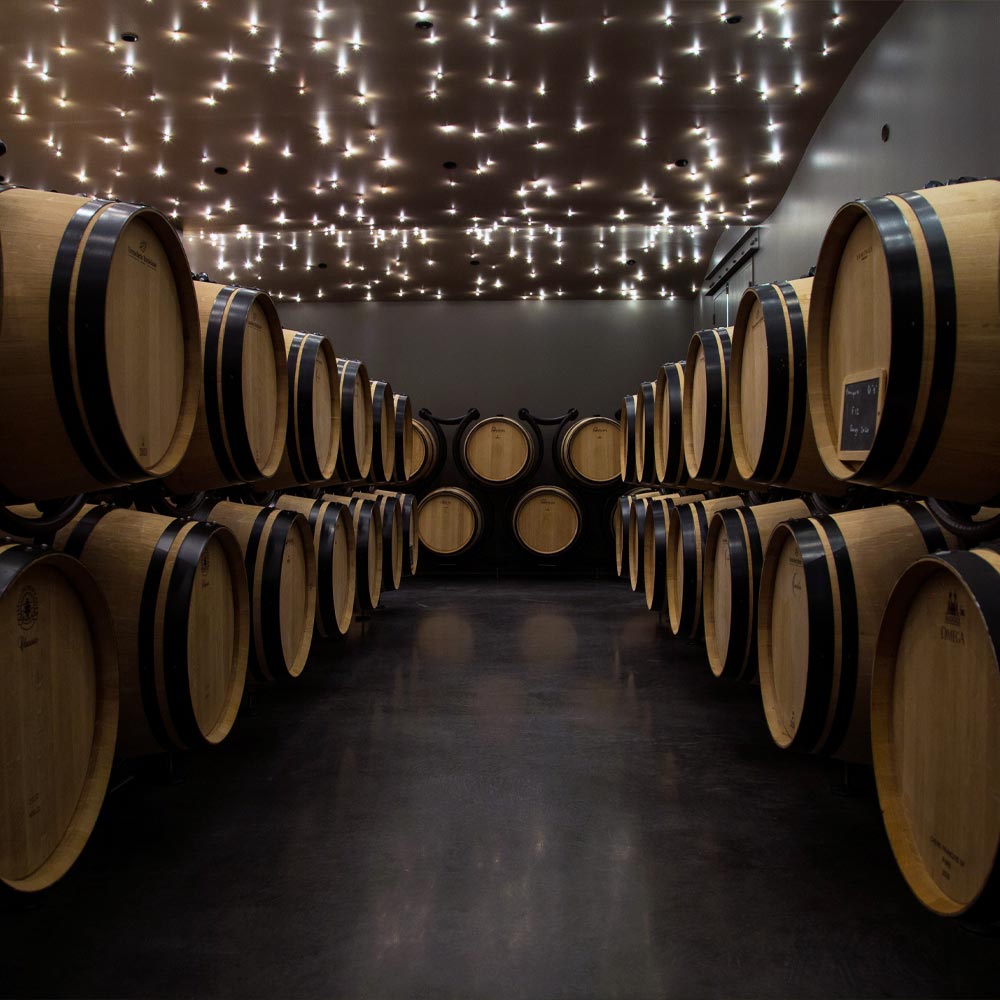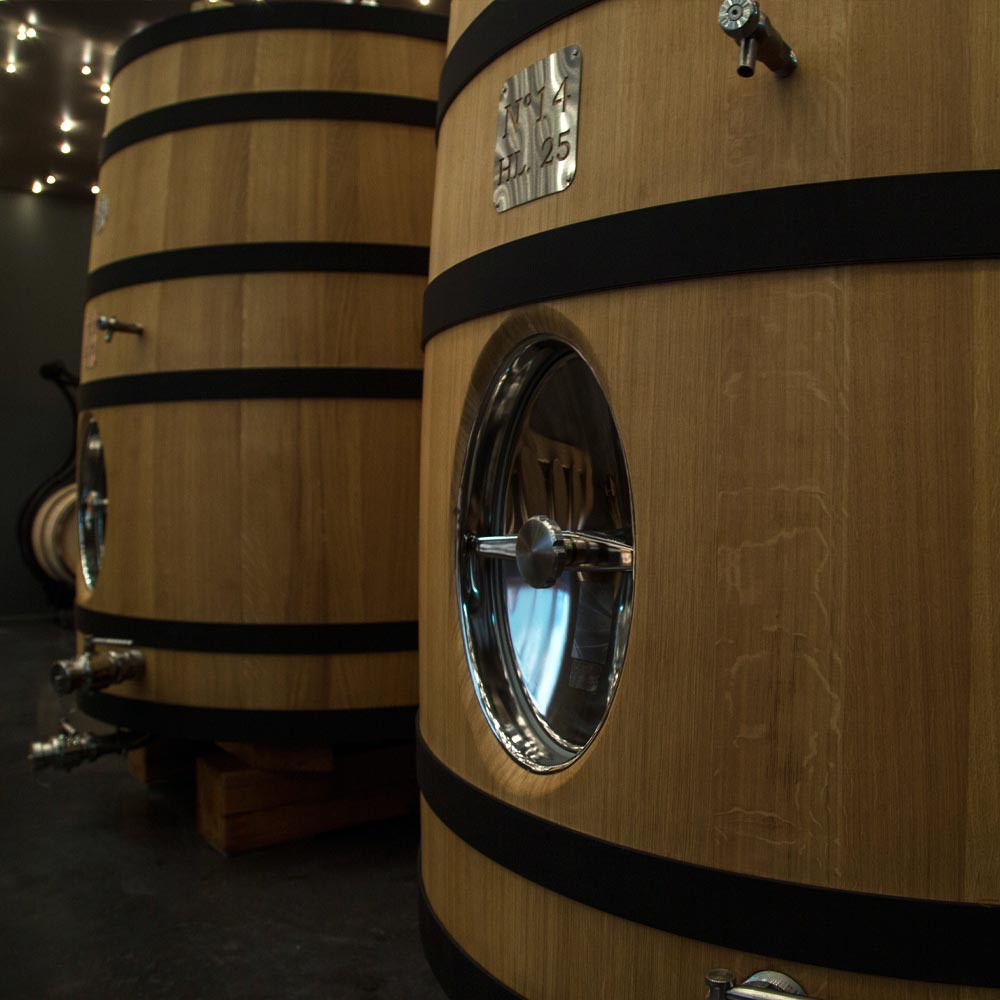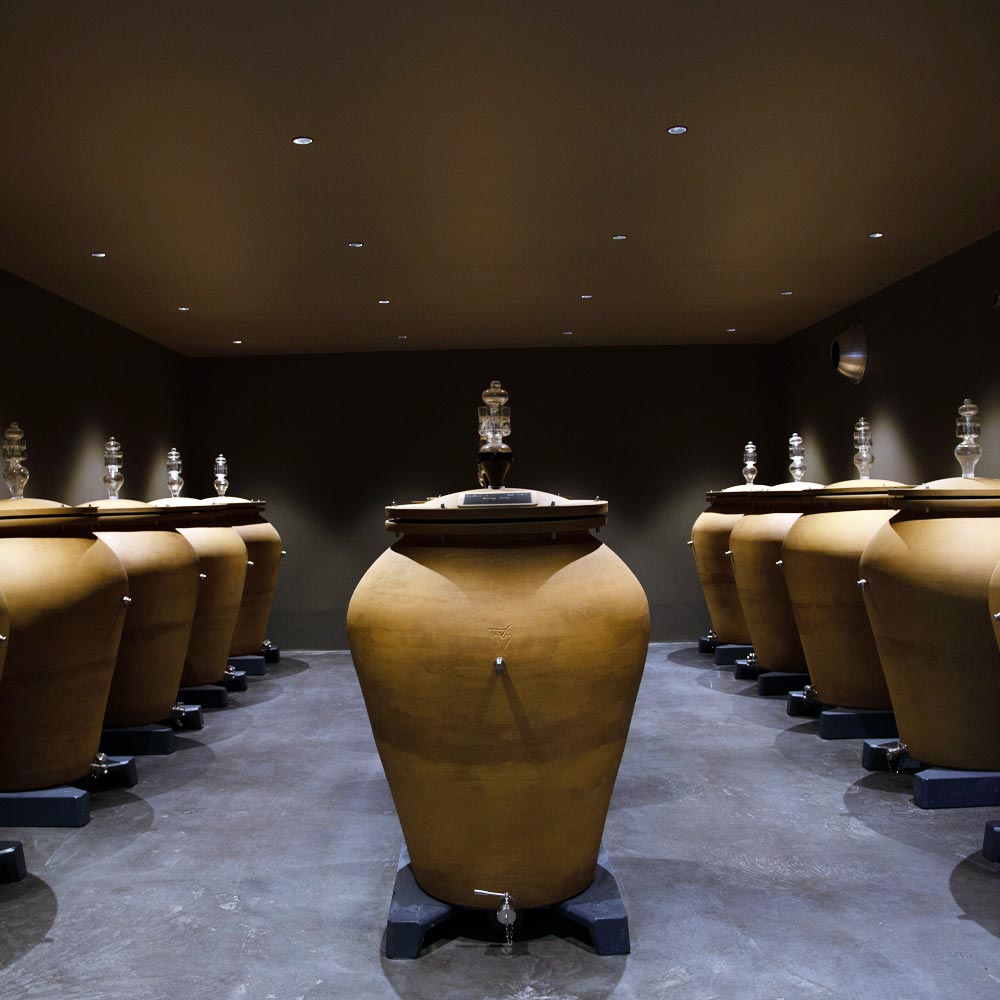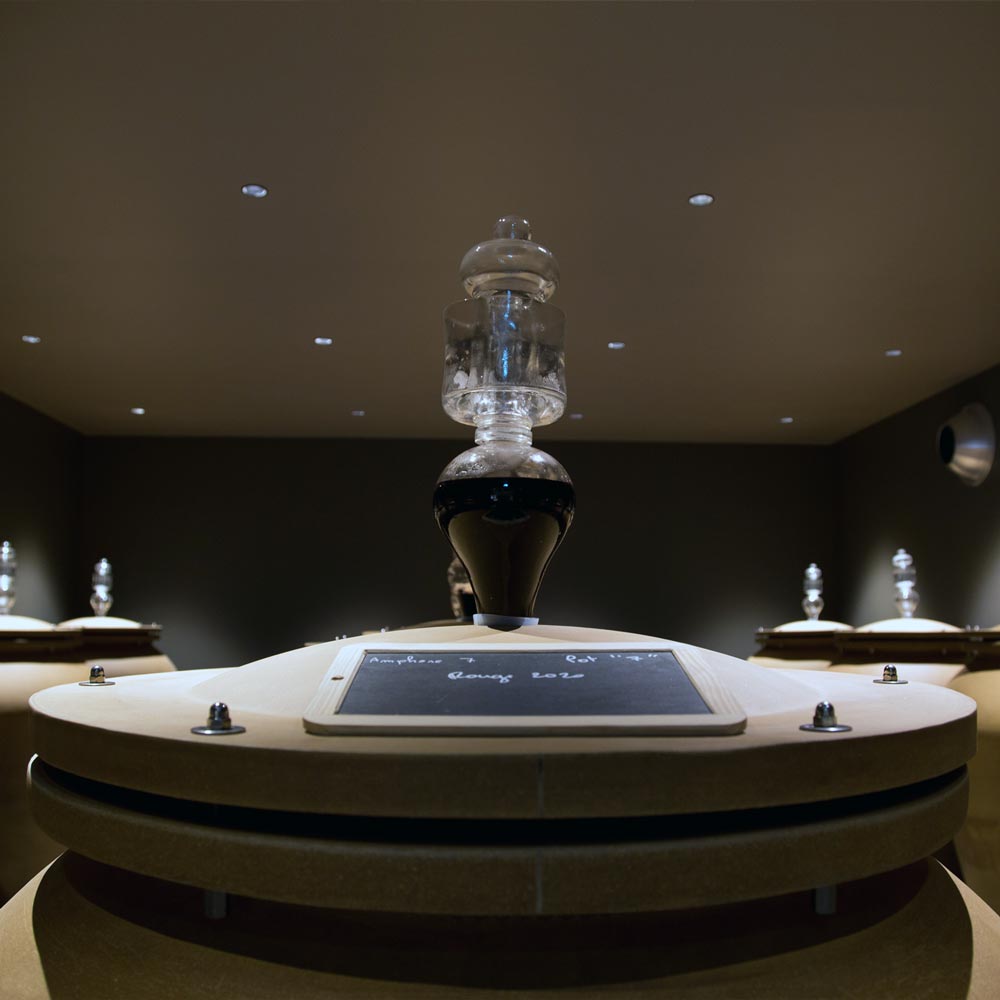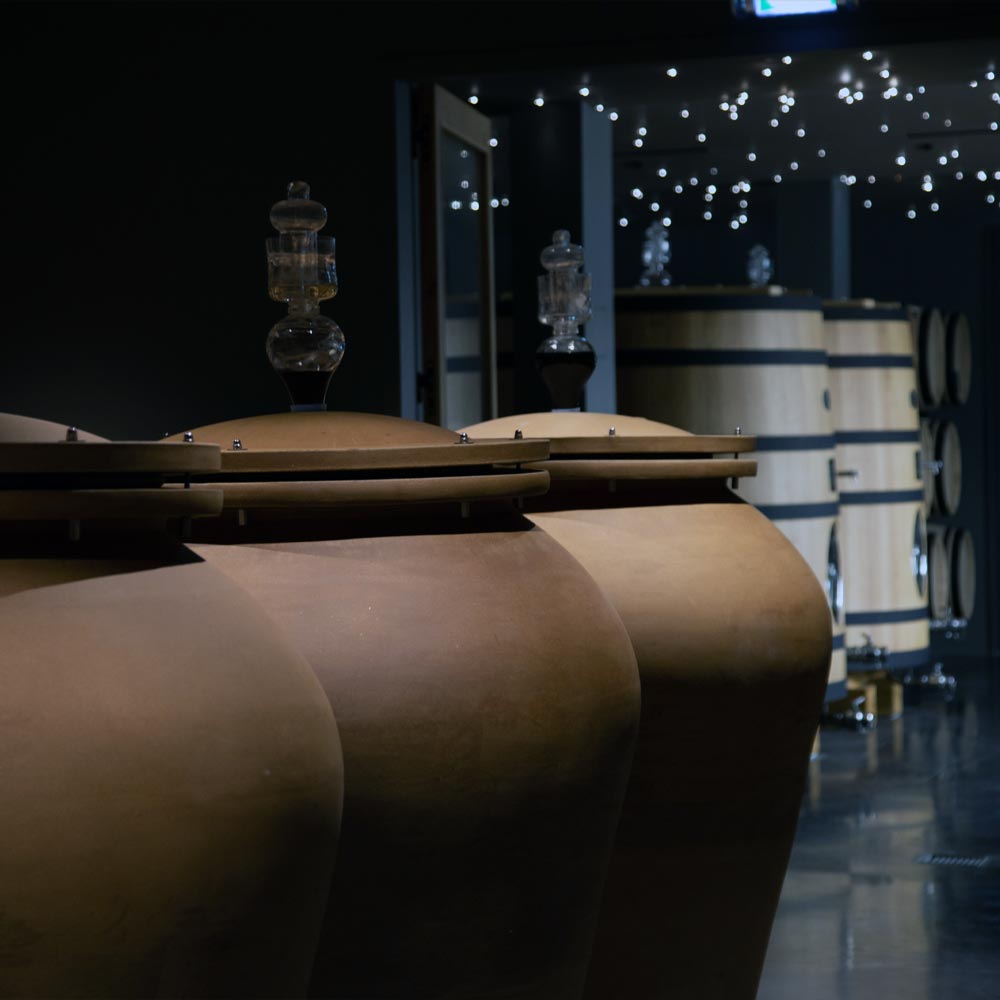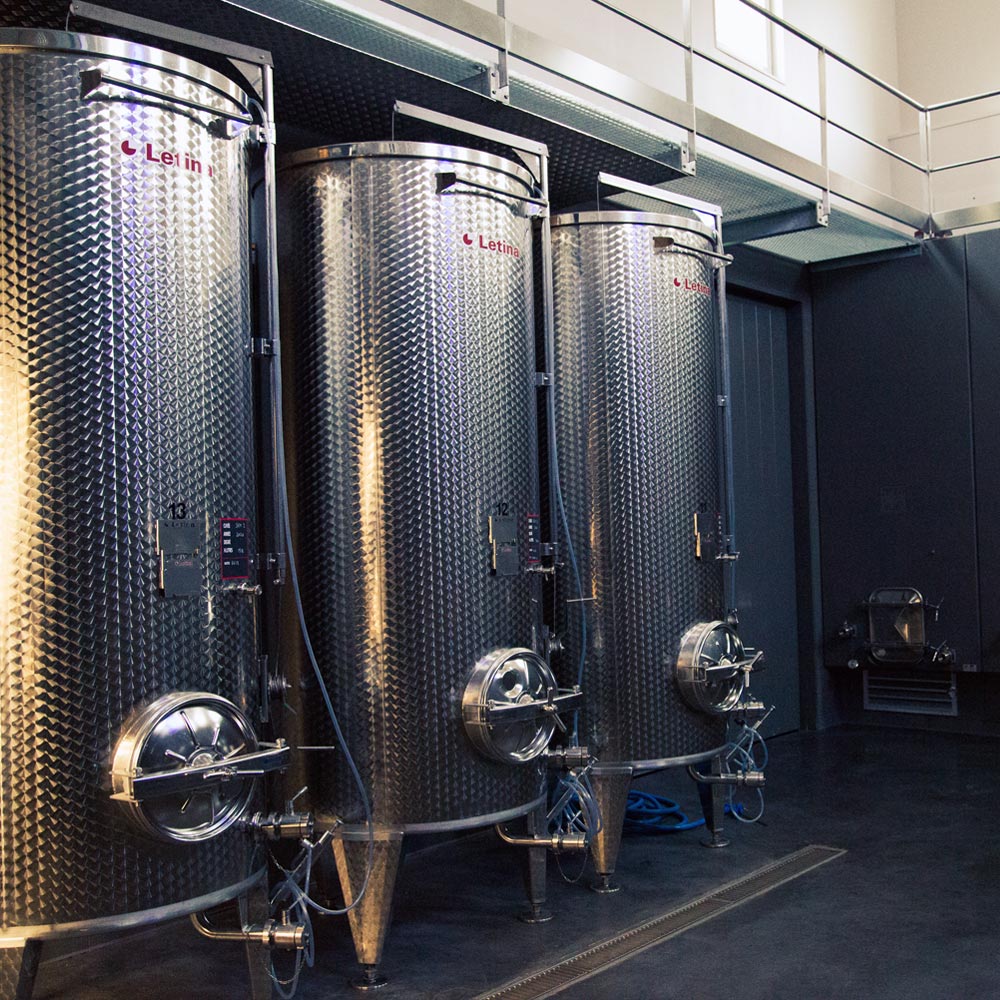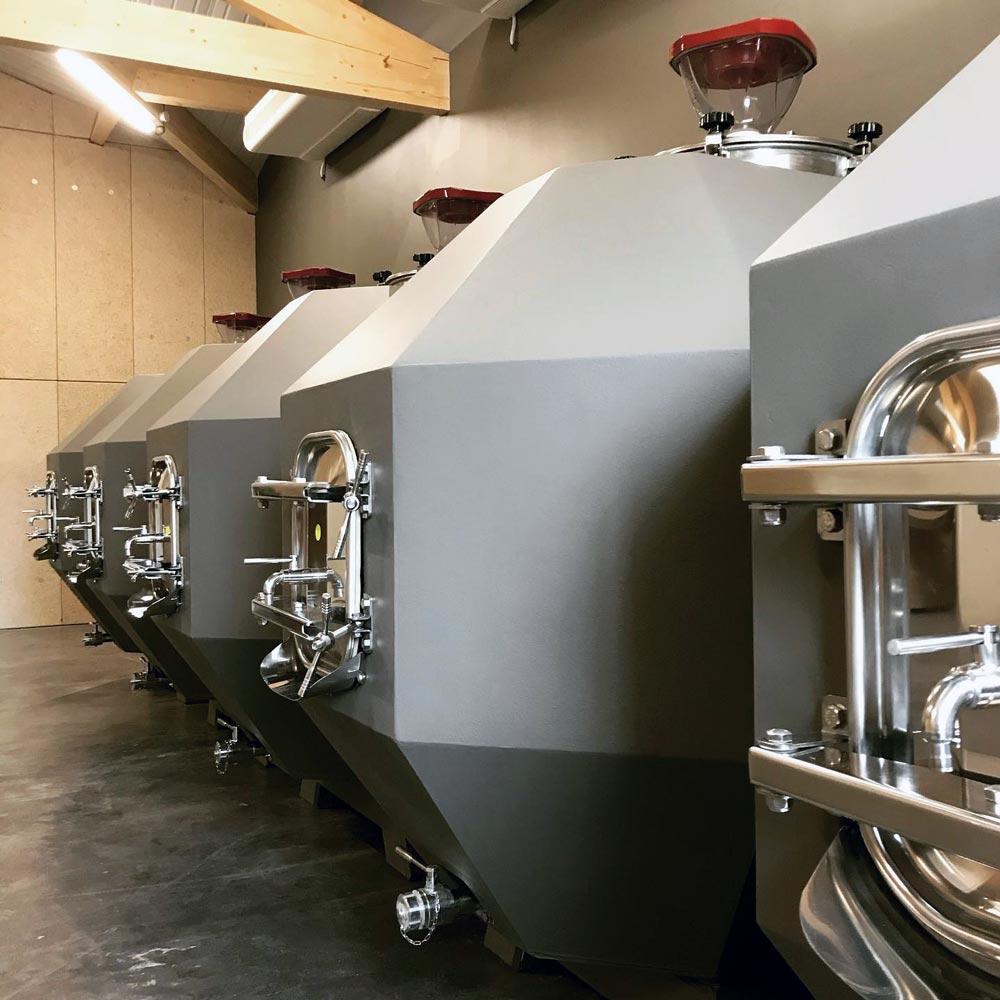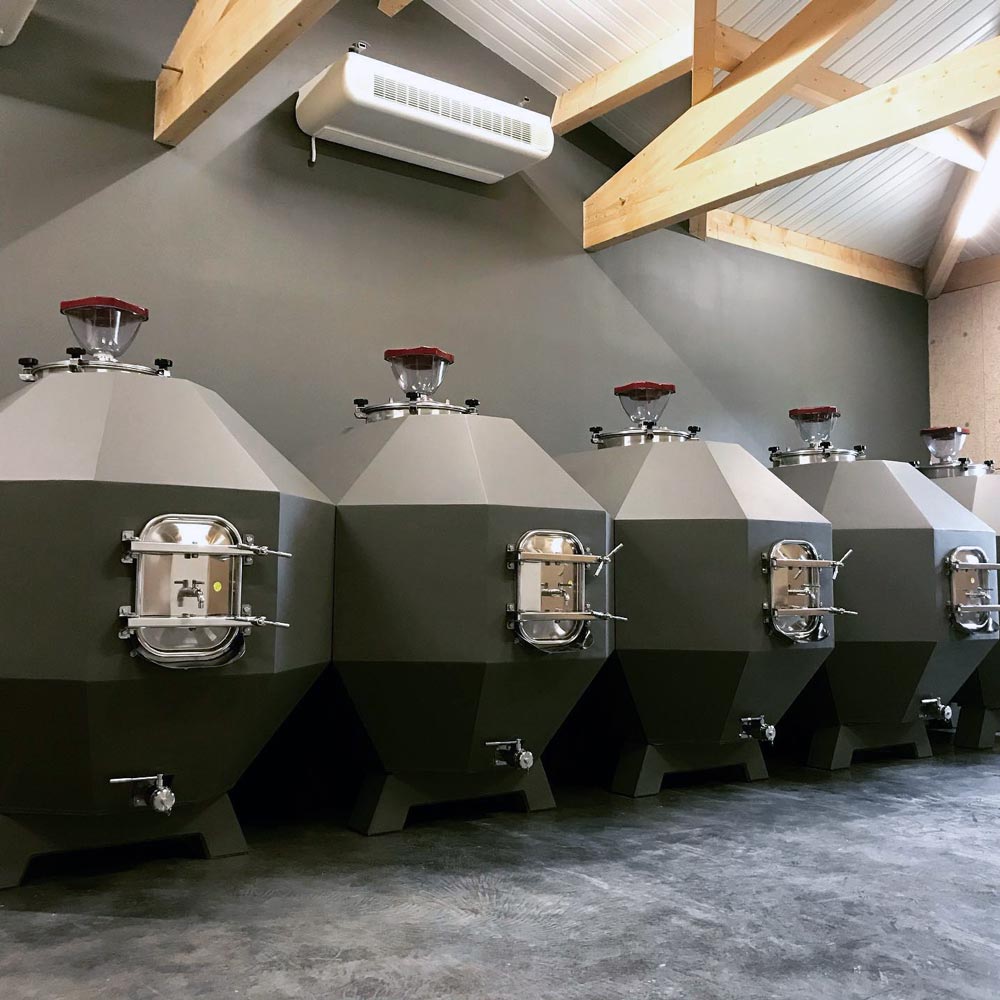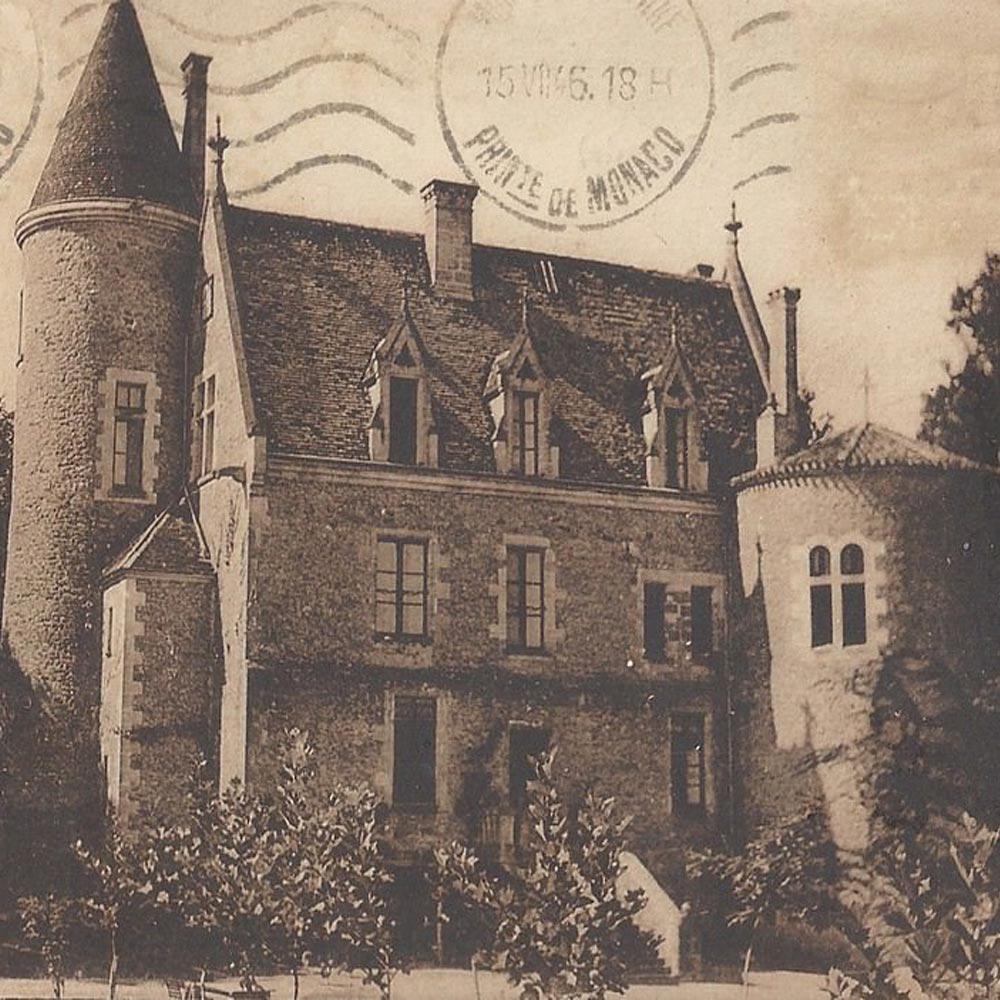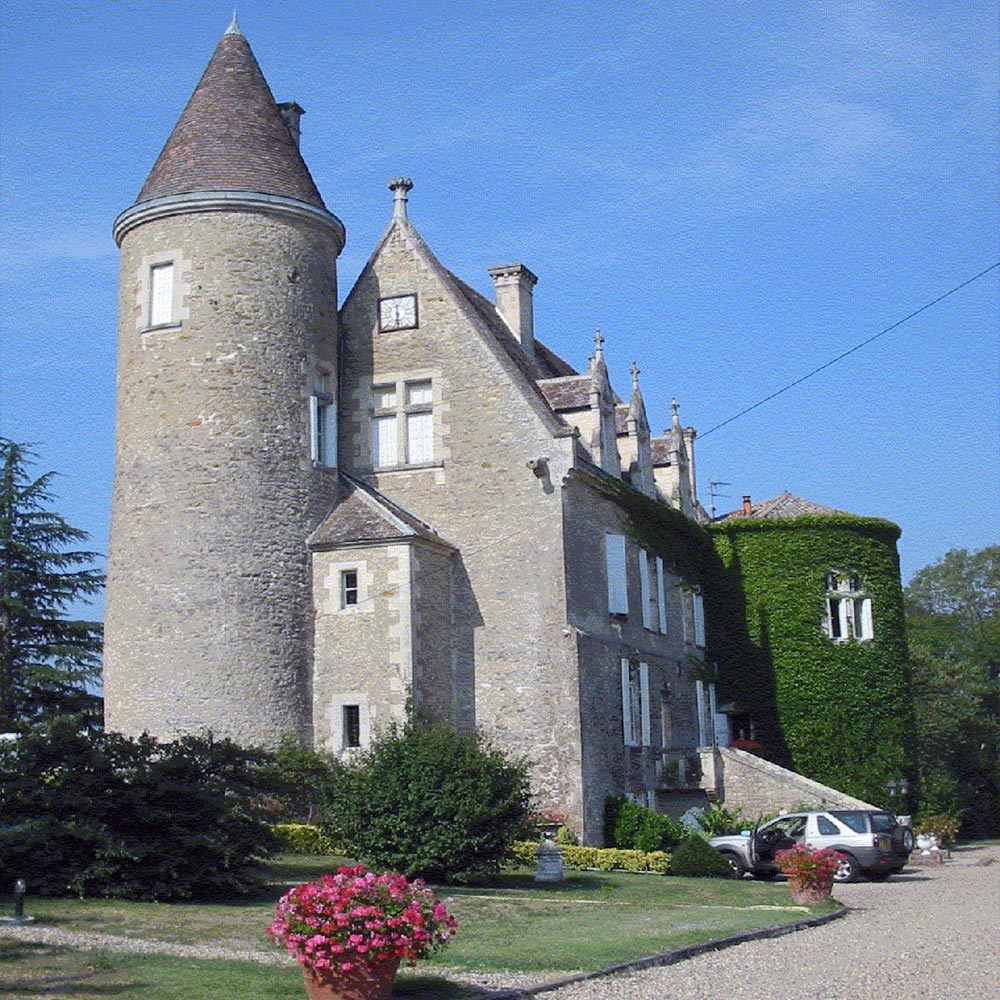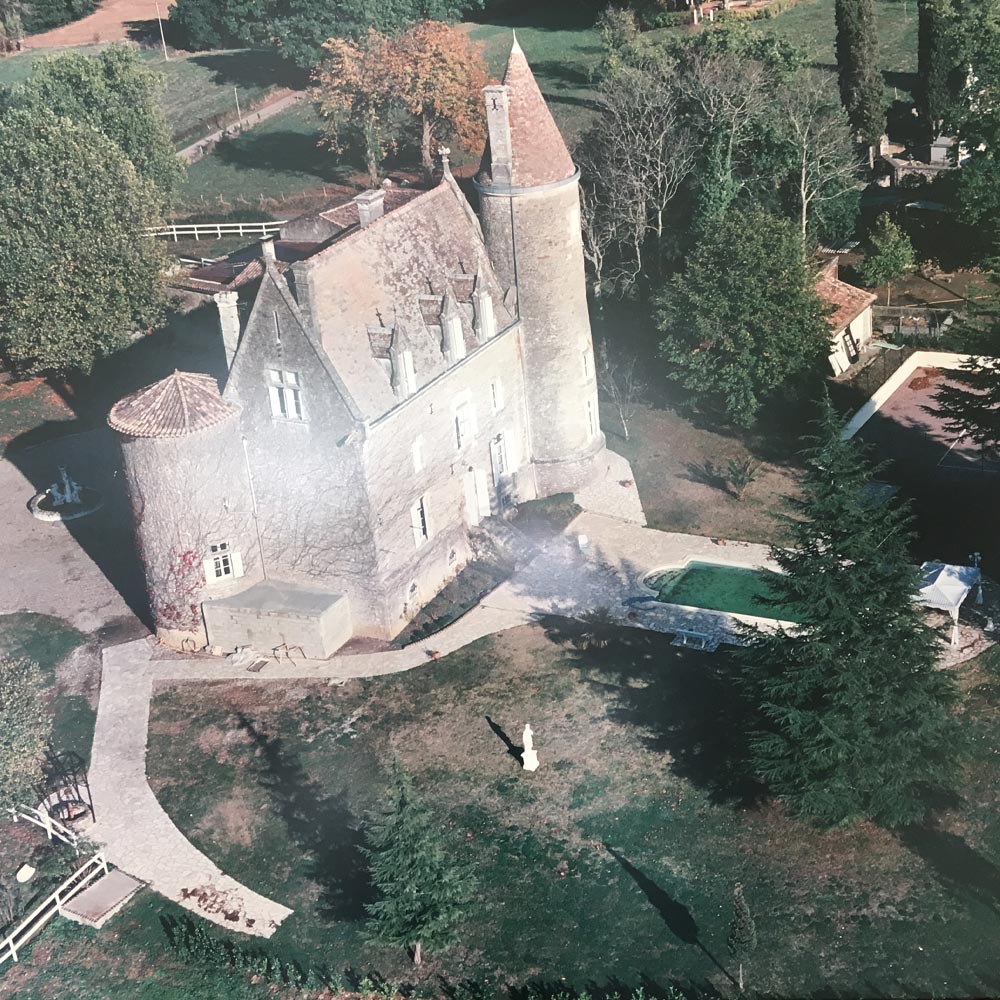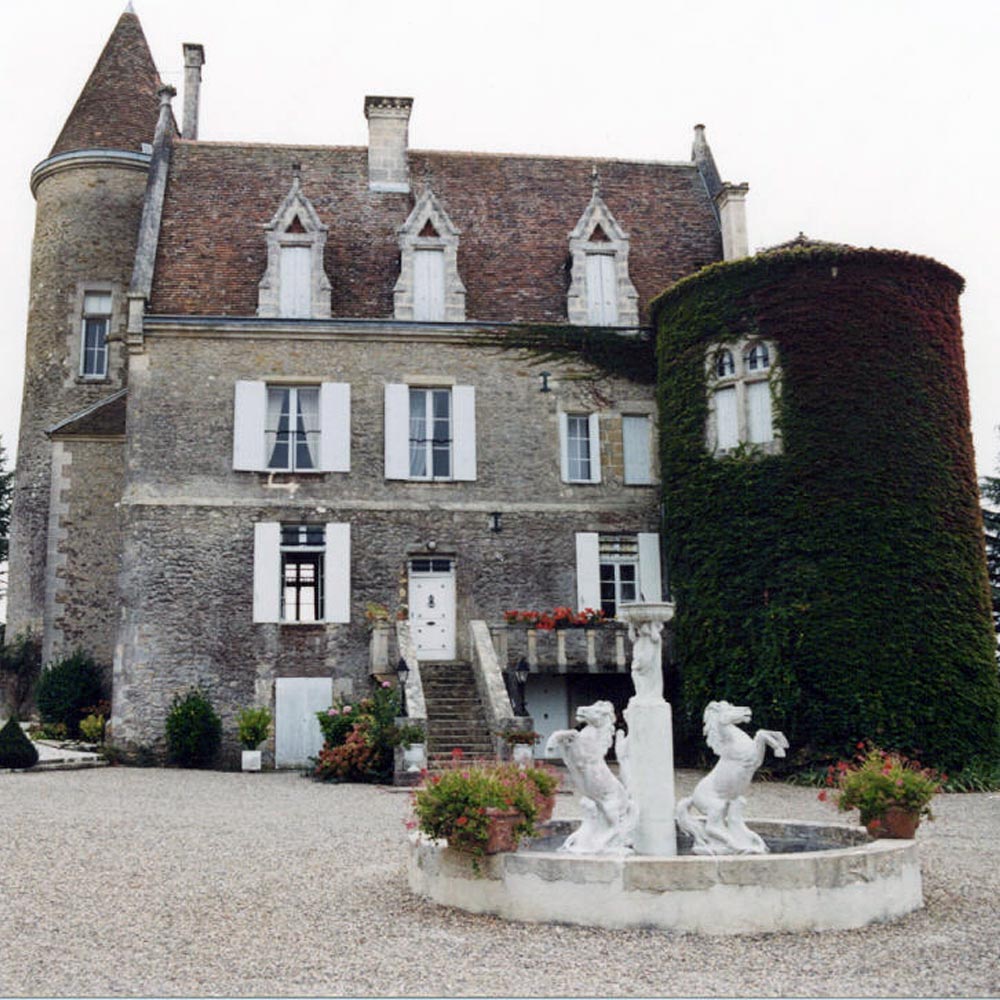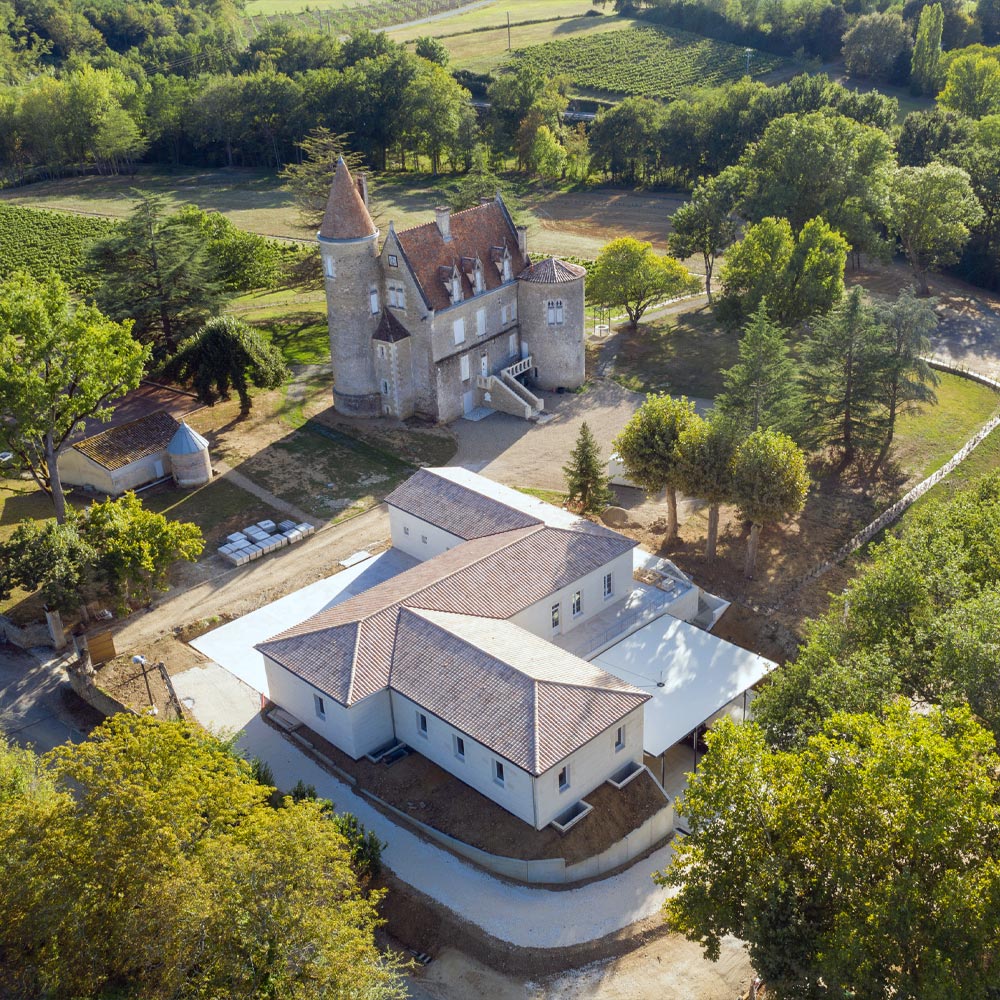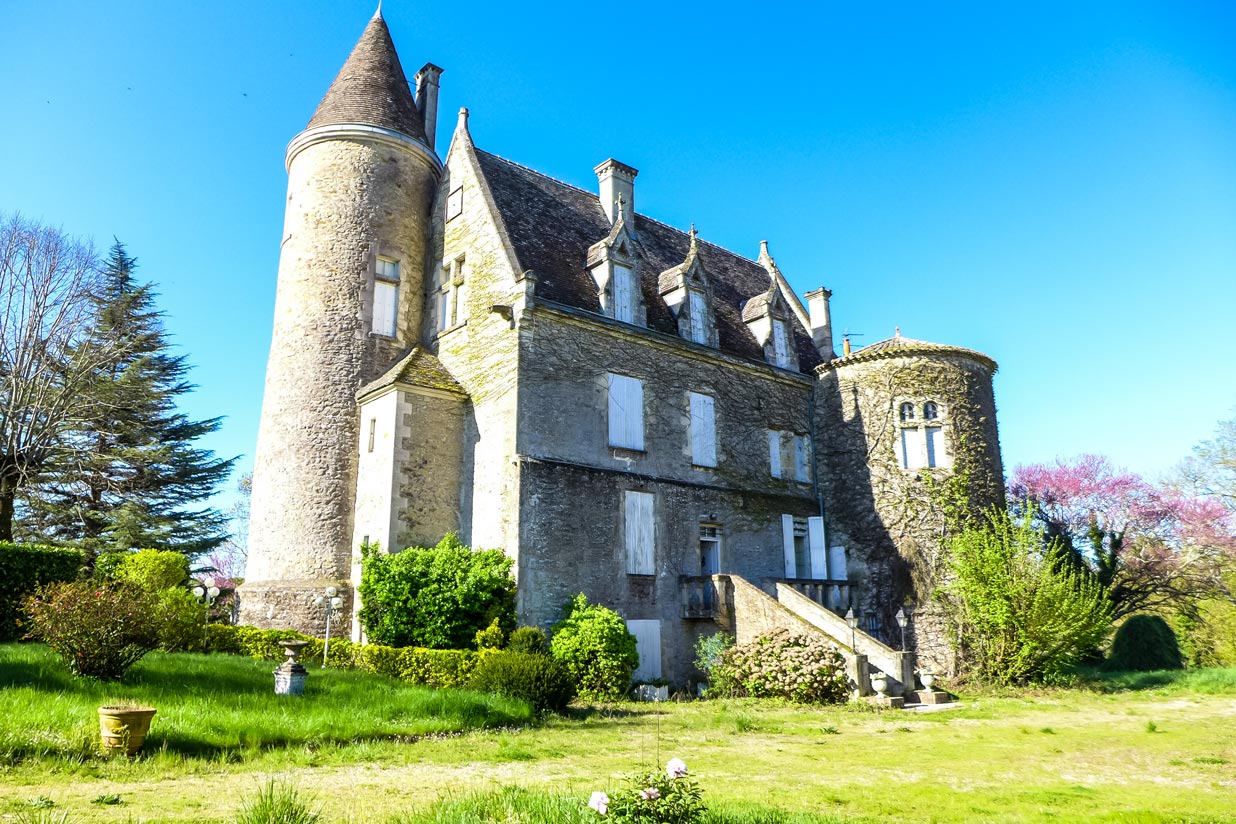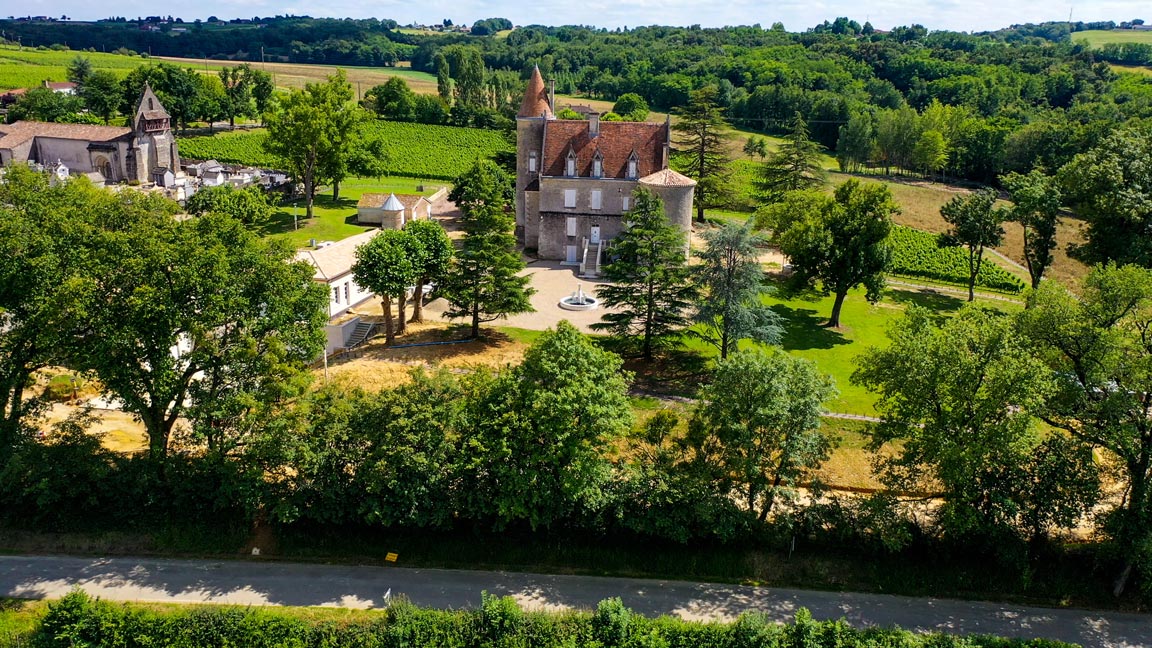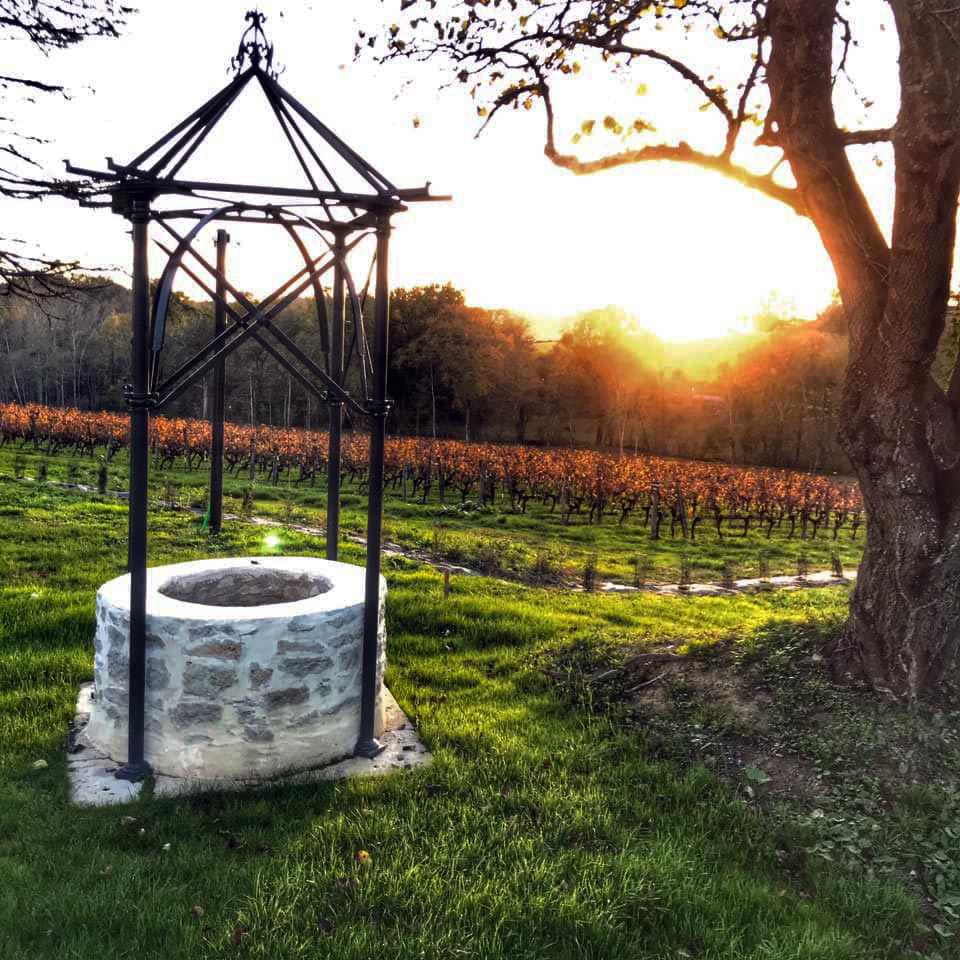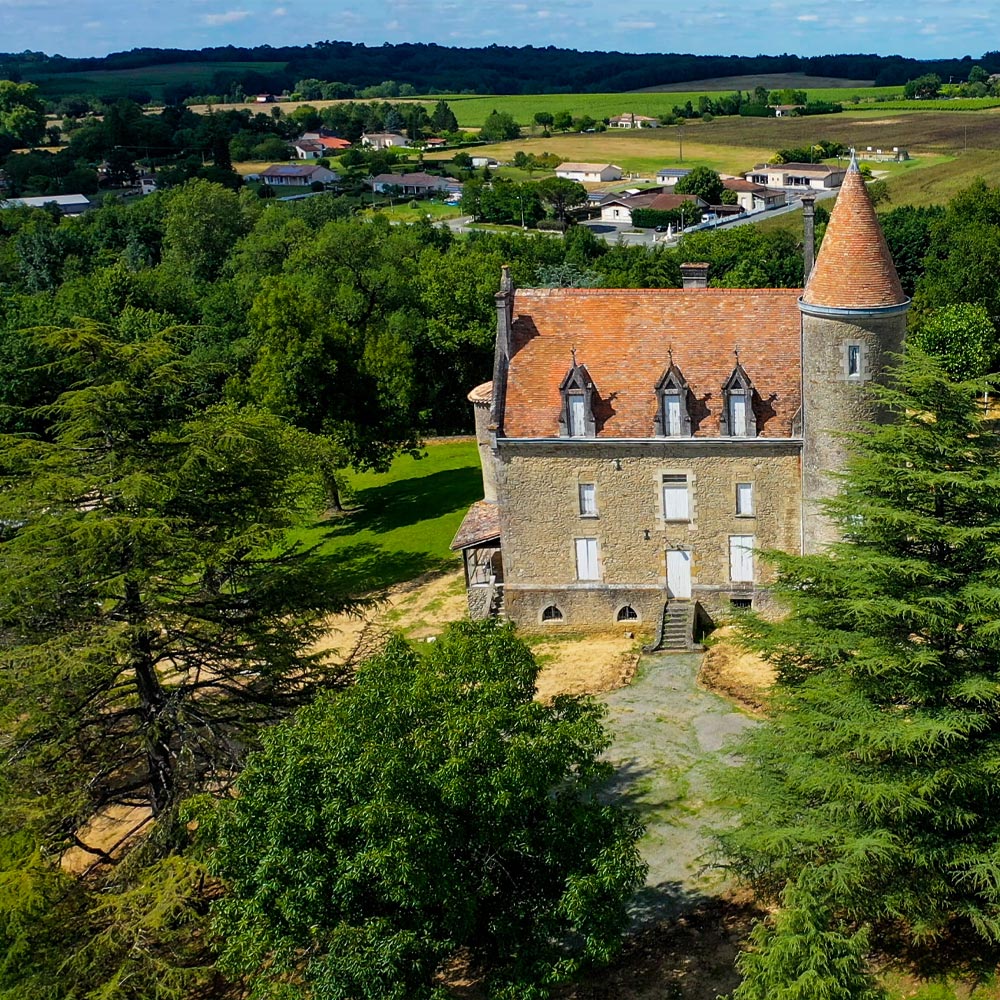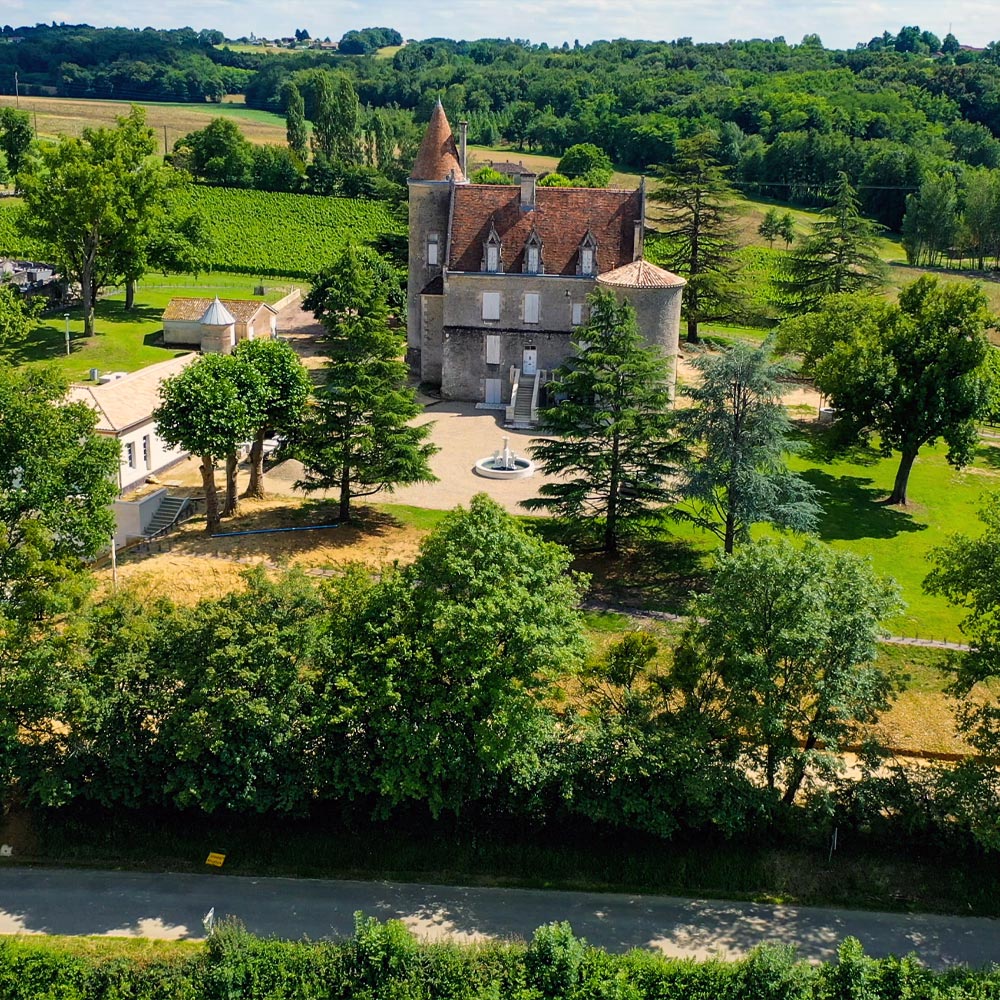The vineyard
When it was established in early 2017, Château de Birazel operated only two hectares of old Merlot vines that were planted to the South of the castle in 1989.
The estate has grown since then, and of the 33 hectares that make it up today, 17 are devoted to the growing of grapes.
An additional 14.5 hectares of vineyards were acquired during the late months of 2017, adding new varieties of grapes including Carménère and Cabernet Sauvignon. They are spread across several parcels of land within a 10 minute drive from the château.
20% of the vines are almost 30 years old, and 70% are over 20 years old.
A first hectare of white and grey Sauvignon is scheduled to be planted soon.
Tillage practices: the soils between the feet of the vines are worked mechanically. A maintained grass cover between the rows helps to improve the structure and bearing capacity of the soil.
Water is treated to optimize effectiveness and reduce the consumption of plant protection products.
Ecological hedgerows accommodate pollinating insects, bees in particular, while nest boxes welcome birds. Hedges prevent the drift of phytosanitary products and protect waterways.
In 2023 Château de Birazel starts its process to obtain its bio certification by 2025 – 2026.
The cellar
Château de Birazel inaugurated its new state-of-the-art wine facility in September 2020, after 14 months of construction.
Ultramodern, meticulously thought out and designed to produce wines of the highest quality, masterfully executed by skilled and mostly local contractors, the cellar houses the ultimate in wine-making equipment and practices:
Design & Project management
Structural design by Gerard Vacheyrout, executed by Audebert and JML; Florian Vidard (Cabinet Touton) was responsible for the follow-up and finalisation of the project.

Waterproofing
Nuvene, St André et Debout.
Indoor facilities
CEME, Lamouroux et Pauquet ; finishing stage by Gettoni et Darcos.
Security & Protection
Prault et Malambic.
Vinification equipment
Rullier, L’Eveque, Agrifoy, Mabelvigne et Petureau.

Surveys & compliance
Bruno Escaich, Energie concept, Qualiconsult, J2C.
Wine-making equipment
DeltaSud, TAVA. Large oak vats supplied by Radoux
The castle
Château de Birazel is located in Saint-Hilaire-de-la-Noaille, in the Gironde region in the South-West of France, specifically the Entre-deux-Mers area, a few steps from the Santiago de Compostella trail.
The ownership of the castle was passed on from the de Birazel family in 1837, to a series of prestigious local owners ranging from military officers to doctors, before Paul Boeckx and Nicole Smits acquired the estate in 2017.
The oldest part of the existing castle is the majestic tower dating back to the 12th century.
It was initially designed to survey the surrounding lands for upcoming threats. The castle functioned as part of a network and communicated to neighbouring castles and fortresses via means of light signals and pigeons.
The actual castlewas erected starting from the remnants of a large square castle that dates back to the 17th century, along with a water-well. The historical tower was maintained. In 1661 it was mentioned as being part of the “fief” given to “noble” Jean de Birazel, “squire and first Jurat of La Réole”.
The park
Every historic estate worthy of the name comes with a majestic park. Eleven hectares were added to the lush sanctuary of Château de Birazel early 2018, bringing it to a total of 14.5 hectares.
Over 120 mature trees thrive there, including a hundred precious specimens, with a majority of oaks, but also hornbeams, cedars, limes, hazels, and plane trees.
Watered by the Ruisseau de Marquelot, a small Natura 2000 protected stream, the park will soon count 6 hectares of truffle oaks, 2 hectares of olive trees, and lavender.
After a first very needed upgrade and cleaning phase by the Château’s team, the final organisation and maintenance of the park has been entrusted to a dedicated gardner.
The team would love to share the park with the public in the future, according to a yet-to-find formula consistent with the philosophy, environment, and activity of the Château. A 600-meter pedestrian route is in preparation.
The vineyard
When it was established in early 2017, Château de Birazel operated only two hectares of old Merlot vines that were planted to the South of the castle in 1989.
The estate has grown since then, and of the 33 hectares that make it up today, 17 are devoted to the growing of grapes.
An additional 14.5 hectares of vineyards were acquired during the late months of 2017, adding new varieties of grapes including Carménère and Cabernet Sauvignon.
They are spread across several parcels of land within a 10 minute drive from the château.
20% of the vines are almost 30 years old, and 70% are over 20 years old. A first hectare of white and grey Sauvignon is scheduled to be planted soon.
Tillage practices: the soils between the feet of the vines are worked mechanically. A maintained grass cover between the rows helps to improve the structure and bearing capacity of the soil.
Water is treated to optimize effectiveness and reduce the consumption of plant protection products. Ecological hedgerows accommodate pollinating insects, bees in particular, while nest boxes welcome birds. Hedges prevent the drift of phytosanitary products and protect waterways. In 2023 Château de Birazel starts its process to obtain its bio certification by 2025 – 2026.
The cellar
Château de Birazel inaugurated its new state-of-the-art wine facility in September 2020, after 14 months of construction.
Ultramodern, meticulously thought out and designed to produce wines of the highest quality, masterfully executed by skilled and mostly local contractors, the cellar houses the ultimate in wine-making equipment and practices:
Design & Project management
Structural design by Gerard Vacheyrout, executed by Audebert and JML; Florian Vidard (Cabinet Touton) was responsible for the follow-up and finalisation of the project.

Waterproofing
Nuvene, St André et Debout.
Indoor facilities
CEME, Lamouroux et Pauquet ; finishing stage by Gettoni et Darcos.
Security & Protection
Prault et Malambic.
Vinification equipment
Rullier, L’Eveque, Agrifoy, Mabelvigne et Petureau.

Surveys & compliance
Bruno Escaich, Energie concept, Qualiconsult, J2C.
Wine-making equipment
DeltaSud, TAVA. Large oak vats supplied by Radoux
The castle
Château de Birazel is located in Saint-Hilaire-de-la-Noaille, in the Gironde region in the South-West of France, specifically the Entre-deux-Mers area, a few steps from the Santiago de Compostella trail.
The ownership of the castle was passed on from the de Birazel family in 1837, to a series of prestigious local owners ranging from military officers to doctors, before Paul Boeckx and Nicole Smits acquired the estate in 2017.
The castle
Château de Birazel is located in Saint-Hilaire-de-la-Noaille, in the Gironde region in the South-West of France, specifically the Entre-deux-Mers area, a few steps from the Santiago de Compostella trail.
The ownership of the castle was passed on from the de Birazel family in 1837, to a series of prestigious local owners ranging from military officers to doctors, before Paul Boeckx and Nicole Smits acquired the estate in 2017.
The oldest part of the existing castle is the majestic tower dating back to the 12th century.
It was initially designed to survey the surrounding lands for upcoming threats. The castle functioned as part of a network and communicated to neighbouring castles and fortresses via means of light signals and pigeons.
The actual castlewas erected starting from the remnants of a large square castle that dates back to the 17th century, along with a water-well. The historical tower was maintained. In 1661 it was mentioned as being part of the “fief” given to “noble” Jean de Birazel, “squire and first Jurat of La Réole”.
The oldest part of the existing castle is the majestic tower dating back to the 12th century.
It was initially designed to survey the surrounding lands for upcoming threats. The castle functioned as part of a network and communicated to neighbouring castles and fortresses via means of light signals and pigeons.
The actual castlewas erected starting from the remnants of a large square castle that dates back to the 17th century, along with a water-well. The historical tower was maintained. In 1661 it was mentioned as being part of the “fief” given to “noble” Jean de Birazel, “squire and first Jurat of La Réole”.
Every historic estate worthy of the name comes with a majestic park. Eleven hectares were added to the lush sanctuary of Château de Birazel early 2018, bringing it to a total of 14.5 hectares.
The park
Every historic estate worthy of the name comes with a majestic park. Eleven hectares were added to the lush sanctuary of Château de Birazel early 2018, bringing it to a total of 14.5 hectares.
Over 120 mature trees thrive there, including a hundred precious specimens, with a majority of oaks, but also hornbeams, cedars, limes, hazels, and plane trees.
Watered by the Ruisseau de Marquelot, a small Natura 2000 protected stream, the park will soon count 6 hectares of truffle oaks, 2 hectares of olive trees, and lavender.
After a first very needed upgrade and cleaning phase by the Château’s team, the final organisation and maintenance of the park has been entrusted to a dedicated gardner.
The team would love to share the park with the public in the future, according to a yet-to-find formula consistent with the philosophy, environment, and activity of the Château. A 600-meter pedestrian route is in preparation.
Over 120 mature trees thrive there, including a hundred precious specimens, with a majority of oaks, but also hornbeams, cedars, limes, hazels, and plane trees.
Watered by the Ruisseau de Marquelot, a small Natura 2000 protected stream, the park will soon count 6 hectares of truffle oaks, 2 hectares of olive trees, and lavender.
After a first very needed upgrade and cleaning phase by the Château’s team, the final organisation and maintenance of the park has been entrusted to a dedicated gardner.
The team would love to share the park with the public in the future, according to a yet-to-find formula consistent with the philosophy, environment, and activity of the Château. A 600-meter pedestrian route is in preparation.
The vineyard
When it was established in early 2017, Château de Birazel operated only two hectares of old Merlot vines that were planted to the South of the castle in 1989.
The estate has grown since then, and of the 33 hectares that make it up today, 17 are devoted to the growing of grapes.
An additional 14.5 hectares of vineyards were acquired during the late months of 2017, adding new varieties of grapes including Carménère and Cabernet Sauvignon. They are spread across several parcels of land within a 10 minute drive from the château.
20% of the vines are almost 30 years old, and 70% are over 20 years old.
A first hectare of white and grey Sauvignon is scheduled to be planted soon.
Tillage practices: the soils between the feet of the vines are worked mechanically. A maintained grass cover between the rows helps to improve the structure and bearing capacity of the soil.
Water is treated to optimize effectiveness and reduce the consumption of plant protection products.
Ecological hedgerows accommodate pollinating insects, bees in particular, while nest boxes welcome birds. Hedges prevent the drift of phytosanitary products and protect waterways.
In 2023 Château de Birazel starts its process to obtain its bio certification by 2025 – 2026.
The cellar
Château de Birazel inaugurated its new state-of-the-art wine facility in September 2020, after 14 months of construction.
Ultramodern, meticulously thought out and designed to produce wines of the highest quality, masterfully executed by skilled and mostly local contractors, the cellar houses the ultimate in wine-making equipment and practices:
Design & Project management
Structural design by Gerard Vacheyrout, executed by Audebert and JML; Florian Vidard (Cabinet Touton) was responsible for the follow-up and finalisation of the project.

Waterproofing
Nuvene, St André et Debout.
Indoor facilities
CEME, Lamouroux et Pauquet ; finishing stage by Gettoni et Darcos.
Security & Protection
Prault et Malambic.
Vinification equipment
Rullier, L’Eveque, Agrifoy, Mabelvigne et Petureau.

Surveys & compliance
Bruno Escaich, Energie concept, Qualiconsult, J2C.
Wine-making equipment
DeltaSud, TAVA. Large oak vats supplied by Radoux
The castle
Château de Birazel is located in Saint-Hilaire-de-la-Noaille, in the Gironde region in the South-West of France, specifically the Entre-deux-Mers area, a few steps from the Santiago de Compostella trail.
The ownership of the castle was passed on from the de Birazel family in 1837, to a series of prestigious local owners ranging from military officers to doctors, before Paul Boeckx and Nicole Smits acquired the estate in 2017.
The oldest part of the existing castle is the majestic tower dating back to the 12th century.
It was initially designed to survey the surrounding lands for upcoming threats. The castle functioned as part of a network and communicated to neighbouring castles and fortresses via means of light signals and pigeons.
The actual castlewas erected starting from the remnants of a large square castle that dates back to the 17th century, along with a water-well. The historical tower was maintained. In 1661 it was mentioned as being part of the “fief” given to “noble” Jean de Birazel, “squire and first Jurat of La Réole”.
Every historic estate worthy of the name comes with a majestic park. Eleven hectares were added to the lush sanctuary of Château de Birazel early 2018, bringing it to a total of 14.5 hectares.
Over 120 mature trees thrive there, including a hundred precious specimens, with a majority of oaks, but also hornbeams, cedars, limes, hazels, and plane trees.
Watered by the Ruisseau de Marquelot, a small Natura 2000 protected stream, the park will soon count 6 hectares of truffle oaks, 2 hectares of olive trees, and lavender.
After a first very needed upgrade and cleaning phase by the Château’s team, the final organisation and maintenance of the park has been entrusted to a dedicated gardner.
The team would love to share the park with the public in the future, according to a yet-to-find formula consistent with the philosophy, environment, and activity of the Château. A 600-meter pedestrian route is in preparation.
